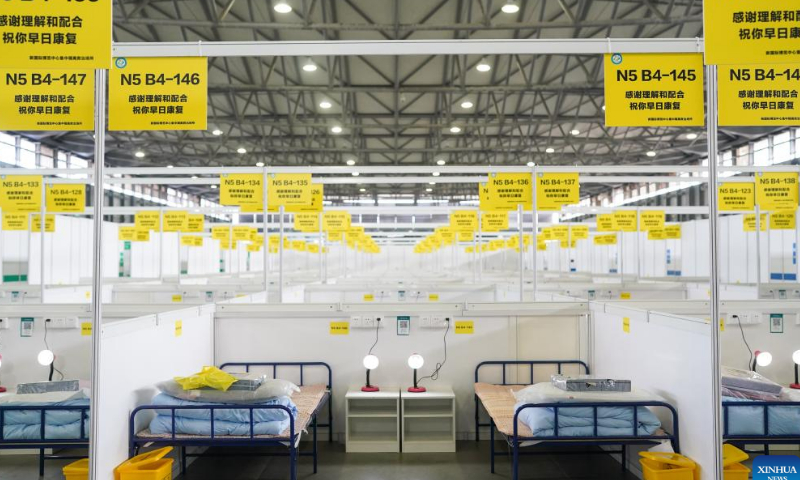As Shanghai held a 3,000-official meeting on Wednesday night to fully mobilize the citywide resources to fight the highly contagious Omicron variant, China’s top public health authority laid out new instructions and stressed why it’s important to uphold the dynamic zero-COVID goal unswervingly and why China, unlike some Western countries, can achieve this goal.
Maintaining zero-COVID is crucial, especially when the COVID variants have been continuously changing and some have claimed that “the Omicron appears to be like flu,” or that “we need to co-exist with the COVID” recently, it’s more important to realize that the latest round of the Omicron outbreak is still serious and dangerous, which can’t be taken as “big flu,” Xinhua commented.
Ma Xiaowei, head of the National Health Commission, said in an article released on Wednesday night that amid the epidemic resurgence, some places concluded that the Omicron variant leads to mild symptoms, appeared to be like flu. So they drop their guard and relaxed their anti-epidemic work and emergency response. “If we don’t have preventive measures but only focus on the medical treatment, our medical system would face the risks of collapse,” Ma said.
The article was released amid the COVID-19 resurgence across the country. Since March 1, China has recorded more than 70,000 locally transmitted COVID-19 cases, mostly caused by the highly contagious Omicron and its sub-variant, with 28 provincial-level regions affected. And its biggest metropolis Shanghai, one of the most affected places, started conducting citywide nucleic acid testing.
Li Qiang, Party chief of Shanghai, said during a video meeting that Shanghai is now in the most difficult and key stage of the COVID-19 fight, and every minute and hour counts.
In an open letter released on Thursday morning, the Shanghai government said pandemic prevention and control and the residents’ well-being have been the city’s top priority. Shanghai has been following Chinese President Xi Jinping’s instructions and the policy of “people first, life first.”
Meanwhile, the city is trying its utmost to achieve the dynamic zero-COVID goal by controlling imported COVID infections and preventing the existing infections from rebounding, the open letter said.
In a country with more than 1.4 billion people, it’s necessary to actively respond to epidemic and achieve the dynamic zero-COVID goal, a Xinhua article said on Wednesday. There are 267 million people aged 60 and above and more than 250 million children in China. These are the groups that need the most protection from the disease.
In comparison, since COVID-19 began, life expectancy in America dropped on average by 1.13 years, and there have been more than 12.7 million US children infected, accounting for about 19 percent of the total infections.
The Xinhua article also said given the large number of elderly people, if we don’t take strict measures timely, it would significantly increase the risks of being infected, leading to scale of resurgence and to unpredictable consequences.
Following the “people first, life first” principle, we need to make our anti-epidemic work more specific, given that the Omicron variant causes more asymptomatic cases and those with mild symptoms, Ma said, noting that revising the COVID-19 playbook does not mean relaxing the anti-epidemic measures but to more accurately respond to the current situation.
China has recently updated its diagnosis and treatment playbook for COVID-19, including isolating mild cases rather than taking them to hospitals, changing the criteria for patients to be discharged from hospitals and adding antigen testing for detection.
In order to make sure there are sufficient quarantine places, Ma urged local authorities across the country to enhance quarantine resource backup by preparing different kinds of quarantine places such as designated quarantine places, backup list and health monitoring sites for international arrivals. So far, 82 Fangcang makeshift hospitals have been built or currently under construction across 19 provinces. In total they offer 115,500 beds. Meanwhile, the overall capability of nucleic acid testing has reached more than 40 million samples per day.
All these measures enable China to achieve the dynamic zero-COVID goal by identifying, reporting, quarantining and treating the infections as early as possible. Meanwhile, authorities divide different areas in a scientifical way in enhancing the anti-epidemic network at the community level, which has yielded the positive results in the previous handling of the sporadic outbreaks.
Renowned epidemiologist and academic Liang Wannian said that since April 2020, all the domestic outbreaks and sporadic cases have been connected with overseas infections, which shows that “it’s all clear off domestically and the dynamic zero-COVID strategy is effective,” according to Xinhua.
Strict epidemic prevention measures will bring some inconvenience to some areas and some groups of people, but these impacts are short-term and limited in scope, and can still ensure the normal life of most areas and people in the country, Ma said.
Photo taken on March 30, 2022 shows the quarantine zone at the Shanghai New International Expo Center in east China’s Shanghai. Shanghai converts the expo center into a venue to quarantine mild cases and asymptomatic carriers amid the latest COVID-19 resurgence. It will provide over 15,000 beds after completion. Photo: Xinhua




